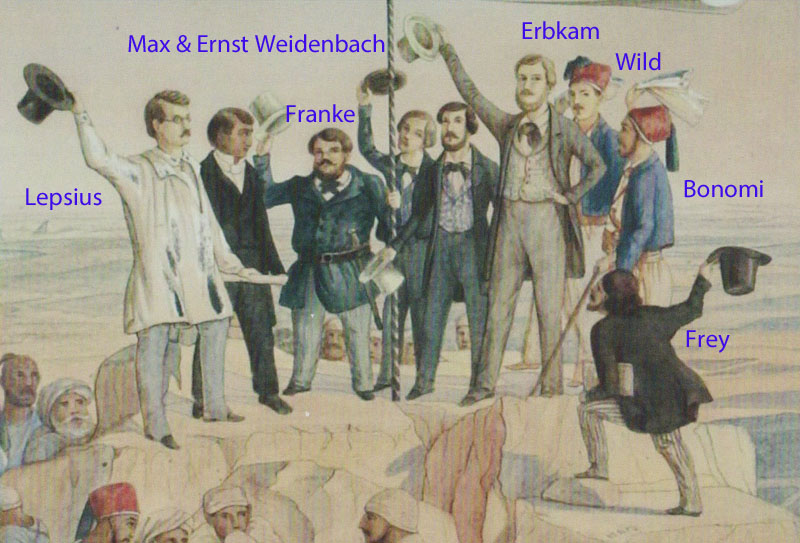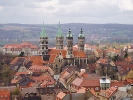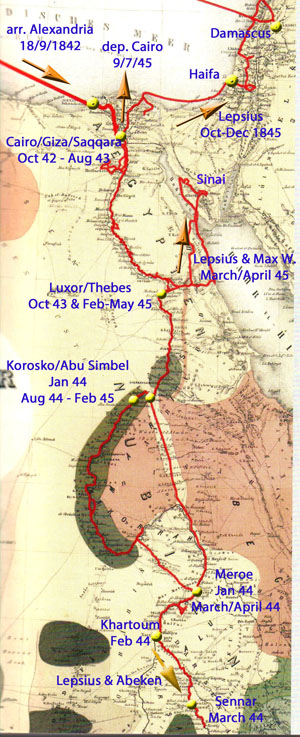In 2012 the Stadtmuseum Naumburg, under the direction of Dr Siegfried Wagner, published "Von Naumburg bis zum Blauen Nil - die Lepsius-Expedition nach Aegypten und Nubien". This is a beautifully produced and illustrated 130 page book describing the Lepsius Expedition, with particular reference to the four Naumburg citizens who comprised half of the Expedition Party. The book is written in German and contains several pages which give an insight into the participation of Ernst and Max Weidenbach. Keith Wallace has translated these pages and they are presented below with due acknowledgement.
We highly commend the book. The many excellent illustrations alone make it a worthwhile acquisition for a non-german reader. Copies can be obtained at a very modest price from the City Museum, Naumburg (www.museumnaumburg.de).

Lepsius was born in Naumburg in December 1810. In 1839, when only 28 years old he dedicated himself to preparations for an expedition to Egypt. At this time he was prepared to lead a private expedition if he could not get government support. Already he had a distinguished record as a linguist and archaeologist. He had studied and worked in Leipzig, Berlin, Paris and Rome and was renowned for his study and interpretation of Egyptian hieroglyphics.
Not only was he a brilliant scholar but must also have been a politically adept organiser and leader. It was quite remarkable that he had inspired the confidence of the leading scientists of his day including the great Alexander von Humboldt, who was renowned for his earlier expeditions in Middle and South America and in Russia.In 1840, Alexander von Humboldt strongly supported Lepsius’ successful application to the newly crowned Prussian King Friedrich Wilhelm IV for support of a Royal Prussian Egyptian Expedition.
From Naumburg to the Blue Nile - the Lepsius-Expedition to Egypt and Nubia
Preparation for the Expedition - by Elke Freier & Alexander Rost
...... p. 29
" The Recruitment of Participants
From the start Max Weidenbach, whom Lepsius knew from Naumburg, was to accompany the expedition. However for his participation it was necessary to obtain a release from military service, which Lepsius arranged personally with the Foreign Office.
For his older brother Ernst he applied direct to the King with the argument that a single draughtsman would be to a large extent fully occupied with copying hieroglyphs and therefore another would be required for sculptures and locations. Also Ernst Weidenbach would be willing to participate if given a free trip, which was good for the budget.
A third artist appears to have been dependent on certain funding requirements. In the case of an approval, Lepsius had in mind Johann Jacob Frey, of whom he had already had positive experience in Italy and France.
The decision for the moulder Carl Franke, who like the Weidenbach brothers came from Naumburg, was also based primarily on financial considerations. In contrast to the others, he was content with a free trip if there was also the prospect of a subsequent position in Berlin.
A further member was to be Georg Erbkam, whose double qualification as architect and draughtsman was of particular interest to Lepsius. Through collaboration with building researchers, Lepsius wanted to soundly fill in the gaps which were apparent in the trip reports of Jean-François Champollion und Ippolito Rosellini. These concerned the precision of building records and the relation between individual presentation and the surroundings. This applied especially to the previously ignored monuments of the old and middle kingdom in the regions of Memphis, Abydos and This, as well as to the Wadi Hammamat, to the Fayum Oasis, to further parts of the Arabian Peninsula as well as the Oases in the Libyan Desert. There, at the same time, drawings, copies and casts were to be made as well as antiquities collected for the Prussian State.
Heinrich Abeken, who was to regularly accompany Lepsius on his separate trips, participated at the Kings expense. He was granted permission on the basis of special service in church policy.
The Leipzig painter Otto Georgi came later from Rome on the recommendation of August Kestner to replace Johann Jacob Frey. "
Two other specialists accompanied the early part of the expedition in 1842/43. They were: Joseph Bonomi the younger, an English sculptor and Egyptologist who had previously worked in Egypt for about eight years and James Wild, an English architect with a special interest in Islamic architecture.
The Participants in the Expedition - by Sabrina Bernhardt & Soeren Franke
...... p. 39
The Weidenbachs
" Ernst Weidenbach (1818-1884)
Ernst Weidenbach was born in Naumburg on the 4th December 1818. As the third child of the landscape painter August Weidenbach he received his first drawing lessons from his father. In 1837 after finishing school he moved to Merseberg and later to Dresden for further education. At the the Industry and Building School of the Dresden Art Academy he attended courses in architectural painting and drawing as well as other courses. Probably on the advice of his younger brother, Maximilian Ferdinand Weidenbach (1823-1892), he went to Berlin at the start of 1840 to be prepared by Lepsius for the tasks in Egypt.
Directly after the conclusion of the Egyptian Expedition in 1845 he was employed on the publication of the results of the expedition. He was responsible for the artistic execution, in which a certain standardisation of the people and animals in the presentation is attributed to him. Besides this he supervised the technical execution of the publication.
In 1865, after a long period of freelance work, Lepsius arranged for Ernst Weidenbach’s employment at the Neue Museum in Berlin. In 1866 he once again accompanied Lepsius to Egypt.
The numerous sketches made by Ernst Weidenbach in Egypt have been used for quite a few book illustrations. Because of his special ability he was given the honourable task of producing, under the supervision of Egyptologist Heinrich Brugsch (1827-1894), watercolour copies of the wall paintings of the rock tombs of Beni Hassan for the 1873 world exhibition in Vienna. These watercolours may be admired today in the Egyptian-Oriental Collection of the Kunsthistorischen Museum in Vienna.
In 1878 he finished working at the Berlin Museum and following a heart attack he moved back to Merseburg, where he died on the 14th September 1884. Lepsius wrote about him: “He is the only Egyptian draughtsman in Berlin and in Germany and the most outstanding of all those available anywhere.” (Letter on the 13th December, 1865)
Maximilian Ferdinand Weidenbach (1823-1890)
Maximilian Ferdinand Weidenbach, the fifth child of the painter August Weidenbach, was born in Naumburg on the 7th March 1823. Like his older brother, he received his first drawing instruction from his father. When he finished school in 1839 Lepsius took the seventeen year old boy to Berlin, to impart to him the knowledge required for graphic documentation of Egyptian antiquities. The first result of the collaboration was in 1842 when Lepsius published the Turin Book of the Dead, to which Weidenbach contributed 79 meticulously accurate lithographs.
The Weidenbach brothers did not only prepare drawings for the Egyptian expedition, they also worked with the painter Georgi who arrived later. In the Sudan, Lepsius was upset with Max Weidenbach because of Max’s breaches of disciple in his conduct towards the leader. However this disagreement could not have lasted long. After their return from Egypt, Lepsius supported the brothers continuing employment. [Lepsius and the brothers worked together in Egypt for another 18 months after Khartoum, including two months in which Max and Lepsius went on a two man expedition to the Sinai. kw]
In 1848 Max Weidenbach followed his second eldest brother Friedrich Moritz to Australia. He was appointed as the first Prussian Consul for South Australia and held this office until 1855. Besides, he operated a successful vineyard. Also, together with other German immigrants, he founded the General German Association. In 1882 he returned to Germany, for the last time, for a year to attend the jubilee reunion of the members of the expedition. He died in Glen Osmond, Australia on the 24th of August 1890 at the age of 67 years.

Lepsius Expedition Participants
"Von Naumburg bis zum Blauen Nil" and kw
"Four Naumbergers on the Nile - by Elke Freier
pp. 68 - 71
Besides Lepsius, the leader of the expedition, three other Naumbergers were selected to participate in the expedition. Max Weidenbach was already trained by Lepsius in hieroglyphic writing a long time before the departure. To gain the king’s support for Ernst Weidenbach, who had in Dresden devoted himself to painting, Lepsius referred the king to a painting by Ernst of the Naumburger Cathedral, thus convincing him of the quality of Ernst’s work.
Lepsius‘ father, Carl Peter Lepsius, recommended the moulder Carl Franke, although he had strong reservations because Franke didn’t have a really good reputation in Naumburg. He promised to travel with them at no charge if he were to get a government job after the expedition and this cost saving was the decisive factor. He was the only one who was already married and for whom the wife had to be taken care of in his absence. She received 70 Thaler per year from the expedition finances.
Georg Erbkam described the four Naumburgers in a letter to his mother and family from Cairo on the 21st of October 1842 [one month after arrival in Egypt - kw]
"At the top is Lepsius. I cannot deny that he is particularly qualified for leadership of an expedition because of his strong character, determination, competence in knowledge and many other praiseworthy characteristics. His knowledge of various languages is invaluable and necessary for such an expedition in which he has to use English, German, French and Italian daily."
And further: "The older Weidenbach is still young and has for me too little life experience and general knowledge. As a Painter he is only a beginner without the talent and enthusiasm of Frey. But he is a good fellow and later on he will certainly be useful in his specialty. The younger Weidenbach is still a lad, at times childish, and requires somewhat strict leadership from Lepsius, because he is careless, although good and skilled and industrious in his work."
But Erkbam, already in the first days of their journey together, had difficulties with Franke due to his outbursts of temper. He characterised Franke as follows: "The last of us, Franke is very corpulent, without being fat, with thick red full moon face, extreme snub nose of which both nostrils lie completely exposed and a strong beard. I do not like him particularly, although he is a cheerful chap, always making jokes, which are however, like his whole education and cultural development, common. In his specialty as moulder, as well as in other practical things, for example - carpentry work etc., he is skilful and very useful.”
Lepsius wrote to his father from Cairo on the 16th October 1842: "Also I can definitely not complain about my companions; a half of whom had already learnt how to travel and the others have learnt it faster than was expected. Each one is very well suited for his position, and this commendation must I particularly give Franke, who at the start aroused your concern. He is a good honest sort and is active not only in his particular art (in which he claims to be called artist) but also in all manual work. He is really skilled as a carpenter, a metal worker, as well as a shoemaker and, when it is necessary, as a cook. In short he is extremely useful, active and obliging.”
In the labyrinth of Hawara in Middle Egypt Lepsius appointed Franke as chief excavation supervisor and on the 15th October 1843 he wrote: "Franke is always in good health and useful but also moody. For his station he is fairly intelligent and wise. However as well as that, he is very conceited and socially ignorant, so that every four to six weeks I must give him a good talking to, to keep him in order. Now things are already going better.”
Yet Lepsius and Erbkam did not only have problems with Franke. As long as there was intensive work to be done, living together went well, but longer stays in towns led not only the servants to imprudence, but also the three Naumburgers. [After 18 months of hard work in the desert Lepsius had lost his patience. - kw ] Lepsius wrote as follows in a letter from the Blue Nile on the 2nd March, 1844.
"Franke, who right from the start has always had a tendency to go his own way, has badly influenced the other two. Max is in his self-confident exuberance really ill-mannered and has become impudent in his behaviour towards Erbkam and me. Ernst in his narrow-mindedness, instead of exerting a controlling influence on his brother as I had hoped, believes that he must as his brother take Max’s part and support Max who is still in his awkward, adolescent phase.
At present in our household, which I cannot keep an eye on in the same way as I did at the start of the journey, everything goes topsy-turvey. Instead of looking after these express matters as before, these ones think only about dress, eating and drinking and enjoying themselves. The Weidenbachs are quite obsessed with dress. Without exaggeration, during the whole trip up until now they have walked about better dressed than Erbkam and me. I go about in wide trousers made of white, light cotton material and wear a long white smock of somewhat stronger material of the same type. Only if I am visiting a Pascha or Mudhir do I wear my European waistcoat and jacket, retaining the same trousers and that is enough. Those ones wear colourful jackets and scarves tailor-made , neck scarves and trousers from better material than I. When I wanted to have Turkish clothing made for Erbkam in Khartoum (as he didn’t have a European suit with him and must from time to time represent me during my frequent absence) they got the idea that everyone wanted to have cloth clothing, regardless of the fact that it was of no use to them and was three times more expensive in Khartoum as in Cairo.
I gave in, as I do for most superficial things of that type. But they carried out the whole of the negotiations with such great impertinence that I have now decided to send all three of them home by the shortest possible route, as soon and we arrive in Lower Egypt again. They are then no longer useful for me. It is a great hardship to travel with so many people. In their case it would perhaps have been difficult for me to have discharged them earlier. If they would have behaved themselves better, I would have quietly ignored these matters. If only they would have just for once forgotten. But having already had three or four such unpleasant scenes with them I will get rid of them as soon as possible.“
However it did not become quite so bad. It was only Franke that Lepsius felt obliged to expel from the expedition and send back while they were still in in Nubia. [Lepsius and the Weidenbach brothers worked together in Egypt for another 18 months after Khartoum, including two months in which Max and Lepsius went on a two man expedition to the Sinai.- kw]
On the 28th May 1844 the following message went from Lepsius at Berg Barkal to Naumburg: “A few days ago Franke departed. I finally had to send him away because his roughness and his stupid temper tantrums erupted time and time again without any motive. It became continually annoying not only for me, but for everyone,. Throughout the whole journey from the beginning up to here he had failed to recognise his position. In many respects he was really helpful and useful but at the last outbreak of his brutality I gladly seized the opportunity to send him away (as he already had been warned often) because, as I have already remarked on a previous occasion, he had a decisively bad influence on his closest campmates, the two Weidenbachs.”
On the 28th of June 1944 it was reported that Otto Georgi had joined the expedition in Barkal and that the Weidenbachs had introduced him to the art of Egyptian drawing.
With that the differences were resolved and there was enough work for all during the return trip through Egypt. Mutual trust between Lepsius and the brothers appears to have been re-established, for Max Weidenbach accompanied Lepsius on the journey to Sinai and drew all that was required. That Lepsius was also at inner peace with the pair is shown by the Christmas greetings which he sent from Constantinople to them in Naumburg in 1845. He was melancholy because at that time was still on the return trip.

